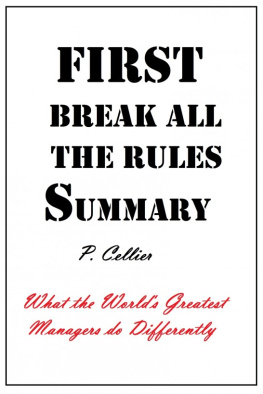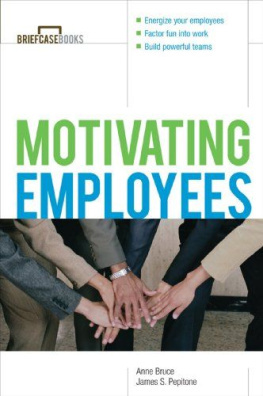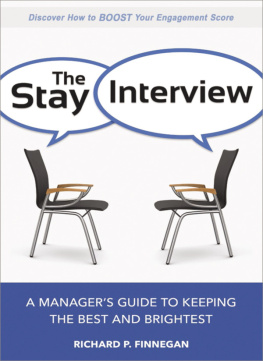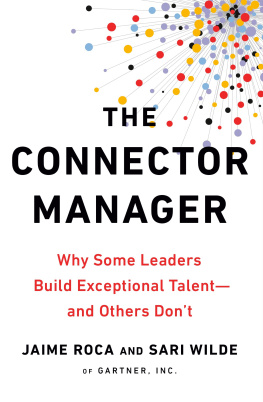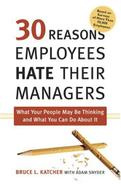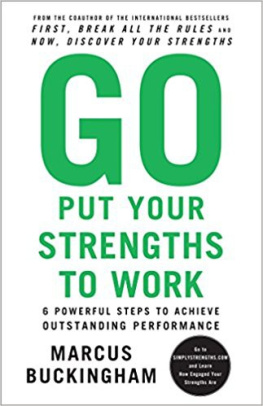Copyright Page
First Break All the Rules Summary
By P. Cellier
Copyright 2007
Smashwords edition.
This ebook is licensed for your personal enjoyment only. Thisebook may not be re-sold or given away to other people. If youwould like to share this book with another person, please purchasean additional copy for each reader. If youre reading this book anddid not purchase it, or it was not purchased for your use only,then please return to Smashwords, Inc and purchase your own copy.Thank you for respecting the hard work of this author.
First Break All the Rules Summary
Introduction.
Based onin-depth interviews with more than 80,000 managers at all levels(and in companies of all sizes), the Gallup OrganizationsBuckingham and Coffman reveal in this summary what great managersdo differently from ordinary managers to coax world classperformance out of their workers. Great managers, write theauthors, routinely break all the rules.
They take theconventional wisdom about human nature and managing people and turnit upside down. In this summary you will learn which conventionalwisdoms to ignore. First, you will find a simple list of twelvequestions that will help you assess whether your workplace is thekind of place that will attract and keep the best employees. Youwill then learn the four keys for unlocking the potential of eachand every one of your employees. The first key is to selectemployees based on talent rather than experience orintelligence.
This summarywill help you learn what talent is and why you cant create it fromscratch. The second key is to evaluate performance based on desiredoutcomes rather than direct control over the way a worker performshis or her job. You will learn how to define outcomes soperformance can be measured and tracked. The third key to greatmanagement is to reject the conventional wisdom that people can befixed. Focus on strength, the authors urge, not on weaknesses. Youwill learn how to manage around weaknesses. The fourth and finalkey is to find the right fit for your employees talents. Again,you will learn to avoid the conventional wisdom that promotion isthe only just reward for high performance - mindset that creates anorganization where everyone is ultimately promoted to their levelof incompetence.
The Measuring Stick
Today, morethan ever, employers realize they must find and keep top talent forevery role. And the approach many of them are taking is to offer anarray of carrots to keep employees happy and around. The problem isthat carrots in the form of perks are expensive and may notaccomplish their purpose. Carrots dont distinguish between greatperformers, mediocre performers or poor ones. Your job, of course,is to attract and keep top performers. Unfortunately, the measuresyou and your company are using to determine if you are succeedingmay not accurately reflect what is really happening. You need a newmeasuring stick. That stick is an assessment of the strength ofyour workplace. Through an extensive survey, the GallupOrganization has isolated the 12 characteristics of a strongworkplace as that workplace is seen through the eyes of the mostsuccessful and productive employees. If employees can answer eachof the following 12 questions affirmatively, you have a strongworkplace, a workplace where the best want to work and stay.
1. Do I know what is expected of me at work?
2. Do I have the equipment and material I need to do my workright?
3. At work, do I have the opportunity to do what I do bestevery day?
4. In the last seven days, have I received recognition orpraise for good work?
5. Does my supervisor or someone at work seem to care aboutme as a person?
6. Is there someone at work who encourages mydevelopment?
7. At work, do my opinions seem to count?
8. Does the mission/purpose of my company make me feel mywork is important?
9. Are my co-workers committed to doing qualitywork?
10. Do I have a best friend at work?
11. In the last six months, have I talked to someone about myprogress?
12. This last year, have I had opportunities at work to learnand grow?
As a manager,it is your job to make sure employees can respond with a resoundingyes to these dozen questions. If they can, you likely have a strongworkplace capable of attracting and keeping top performers at everylevel from the bottom to the top. You probably noticed that thereare no questions about pay, benefits, senior management ororganizational structure on the list. The reason is that those areimportant to every employee, good, bad or mediocre.
Therefore, they arent a true measure of a healthy and strongworkplace. A workplace with nothing but low-performing employeesbut an excellent benefit plan would fare very well on a survey, butthe survey responses would say nothing about how well the companyattracts and keeps the best. And therein lies the folly of the best places to work type surveys. Just because a place is a good place to workdoesnt mean it will attract good workers. It may be a popular butweak workplace.
To test thistheory, The Gallup Organization surveyed 2,500 business units.After assessing their productivity, profitability, retention levelsand customer ratings, employees were asked to answer the 12questions. Consistently, the companies that ranked highest in thefour measures of success had workers who answered the questionsaffirmatively and emphatically. That is, the best business unitshad more workers respond that they strongly agreed with each of the12 questions while the worst business units had fewer workersrespond that way.
There was aclear link between employee opinion and business unit performance.Managers are the key to a strong workplace. Managers who create anenvironment where workers can answer the questions positively arethe managers who will attract and retain the best.
What a Strong Workplace Looks Like
Lankford-Sysco is a strongworkplace. The Ocean City, MD, workplace doesnt look very special.The warehouses are cold and foreboding. Workers clad in arctic wearmove crates in and out of deep freezers. But as you continue yourtour, you quickly notice the workers are focused and cheerful. Inthe lobby there is a huge mural depicting company history as wellas an employee portrait gallery. The company is part of a $15billion food distribution giant, yet resembles the small, familyowned operation it was before merging with industry giant Sysco.The company has a turnover rate in the single digits, absenteeismis at an all-time low, and theft is virtually nonexistent. Companyexecutives think they know the reason. Every employee is paid forperformance regardless of what position he or she holds. Managersconstantly talk about the importance of customers and say theytreat workers with respect and really listen to their concerns. Inturn, workers measure their success by personal bests like breakagerecords and miles traveled without accidents. Virtually everyonewould answer yes to the 12 measuring stick questions.
The Wisdom of Great Managers
How do the best managers in the world lay the foundations ofa strong workplace? The Gallup Organization set out to answer thatquestion in phase two of a massive survey project. First, theresearcher asked clients to identify their best managers, the ones you would dearly love toclone . Next, the managers were evaluatedby standard measures such as the productivity and profitability of theirdivisions , employee accidents, shrinkage, customer feedback and employeeopinion.
Those who scored the best overall were interviewed and askedabout their management practices. Next, another group of managerswas identified. This group did not perform anywhere near the levelof the first set. Instead, they could best be characterized asmediocre. They, too, completed the interview. When the results werecompared, a remarkable discovery came to light. Great managers break all the rules .They ignore the conventional wisdom that says managements job isto identify worker weaknesses and devise a plan to correct andovercome those weaknesses. Instead, they operate on the assumptionthat people dont and probably cant change many of the traits theycarry. Good managers recognize the futility in demanding change andconcentrate instead on developing employee strengths.
Next page
